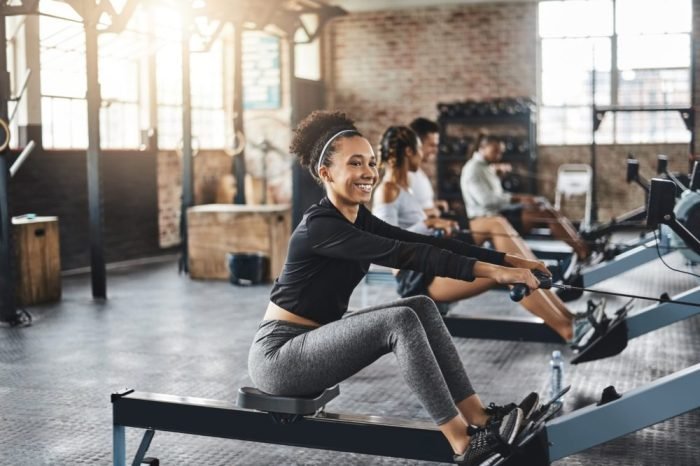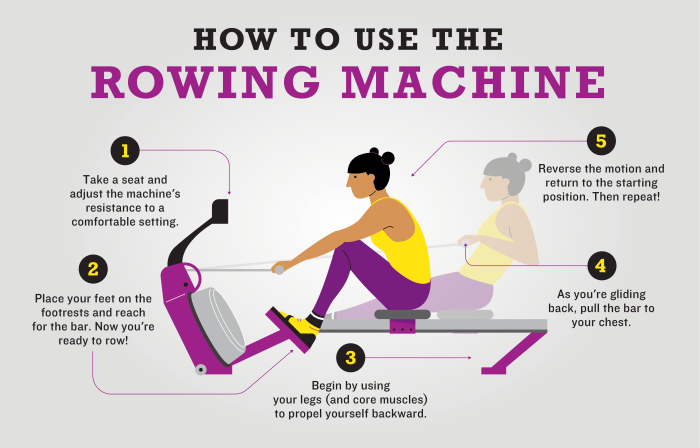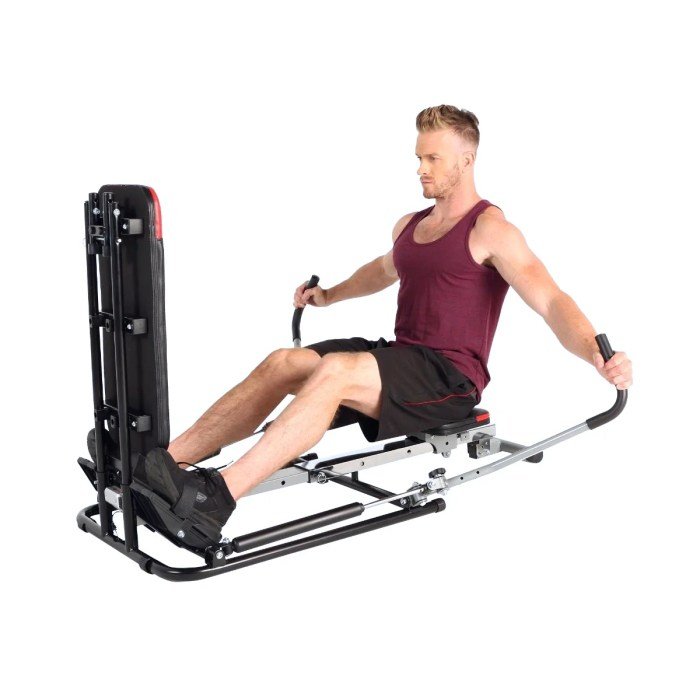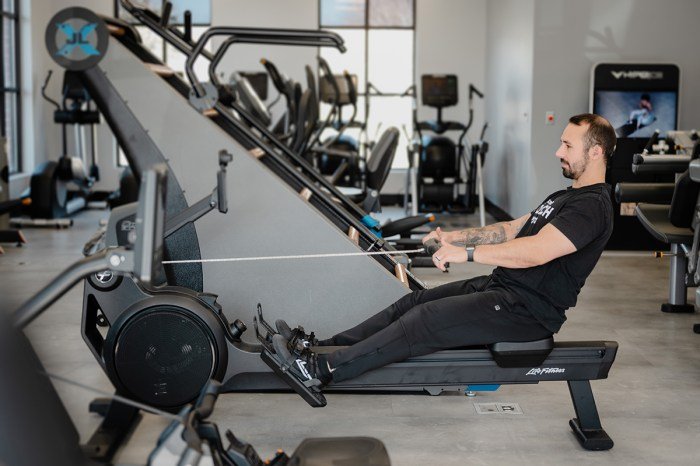Rowing and fitness go hand in hand, offering a comprehensive workout that engages multiple muscle groups, improves cardiovascular health, and boosts overall well-being. Whether you’re seeking a low-impact exercise option or a challenging cardio routine, rowing provides a dynamic and rewarding experience.
From the powerful strokes that propel you forward to the engaging form that requires precision and control, rowing is a multifaceted activity that caters to various fitness goals. Whether you choose to row indoors on an ergometer or embrace the open water, the benefits of rowing extend far beyond physical fitness.
Rowing as a Fitness Activity

Rowing is a full-body workout that offers numerous health benefits. It engages multiple muscle groups, improves cardiovascular health, and enhances endurance.
Benefits of Rowing
Rowing provides a comprehensive workout that benefits your overall fitness. Here are some key advantages:
- Cardiovascular Health:Rowing is an excellent cardio exercise that elevates your heart rate and improves blood circulation, strengthening your heart and lungs.
- Muscle Strength and Endurance:Rowing engages major muscle groups, including your legs, core, back, and arms, building strength and endurance in these areas.
- Low-Impact Exercise:Rowing is a low-impact exercise, placing minimal stress on your joints. This makes it suitable for people of all fitness levels, including those with injuries or limitations.
- Calorie Burning:Rowing is an efficient calorie-burning activity, making it a great choice for weight management or weight loss.
- Improved Posture:Rowing strengthens your core and back muscles, which can help improve your posture and reduce back pain.
Comparison to Other Cardio Exercises
Rowing stands out as a superior cardio exercise compared to others due to its unique advantages:
- Full-Body Workout:Unlike running or cycling, rowing engages multiple muscle groups simultaneously, providing a more comprehensive workout.
- Low-Impact:Rowing’s low-impact nature makes it gentler on joints compared to high-impact exercises like running.
- Improved Core Strength:Rowing significantly strengthens your core muscles, which are crucial for stability and balance.
- Enhanced Endurance:Rowing requires sustained effort, improving your aerobic capacity and overall endurance.
Types of Rowing Workouts
Rowing workouts can be tailored to suit your fitness goals and preferences. Here are some common types:
- Indoor Rowing:Indoor rowing machines provide a controlled environment and allow for structured workouts. You can adjust resistance levels and track your progress.
- Outdoor Rowing:Outdoor rowing, on a lake or river, offers a more scenic and immersive experience. It involves navigating currents and wind conditions, adding an element of challenge.
- Interval Training:This involves alternating between high-intensity bursts and rest periods, enhancing cardiovascular fitness and calorie burning.
- Steady-State Rowing:This involves maintaining a consistent pace for an extended period, improving aerobic endurance and muscle strength.
Rowing Technique and Form

Mastering proper rowing technique is crucial for maximizing efficiency, minimizing risk of injury, and achieving optimal results. A smooth and coordinated rowing stroke engages multiple muscle groups, enhancing overall fitness and endurance.
Proper Rowing Technique
A proper rowing stroke involves a series of coordinated movements, emphasizing biomechanics for optimal power and efficiency. The stroke can be broken down into the following phases:
- Catch:The catch marks the beginning of the stroke, where the rower’s body is fully extended with the arms straight and the legs slightly bent. The oar blade is submerged in the water, angled slightly to create resistance. This is the starting point of the stroke.
Rowing is a fantastic full-body workout that offers a low-impact way to build strength and endurance. If you’re looking for ways to enhance your fitness journey, consider checking out resources like magnus health , which offers a wealth of information on nutrition, fitness, and overall well-being.
With their guidance, you can incorporate rowing into a well-rounded fitness plan that aligns with your goals and helps you achieve optimal results.
- Drive:The drive phase involves a powerful leg drive, followed by a smooth pull with the arms and back. The legs straighten, extending the body and transferring power to the oar blade. The back remains straight, and the shoulders stay low.
This phase generates the primary force for propulsion.
- Finish:As the legs reach full extension, the arms continue to pull, bringing the oar handle towards the chest. The body leans back slightly, maintaining a straight back. The oar blade is fully submerged and angled for optimal water resistance.
- Recovery:The recovery phase begins with a smooth slide forward, with the body returning to the catch position. The arms extend forward, and the oar blade is lifted out of the water. The body is relaxed, and the back remains straight.
Rowing is a fantastic full-body workout that can improve cardiovascular health, build muscle, and enhance endurance. For those interested in pursuing a career in the health sector, a doctor of health administration degree can provide the knowledge and skills needed to lead and manage healthcare organizations.
A deep understanding of fitness and health promotion can be valuable assets in this field, allowing you to advocate for better health outcomes and encourage active lifestyles within communities.
This phase allows the rower to prepare for the next stroke.
Common Rowing Mistakes
Understanding and correcting common rowing mistakes is essential for improving technique and maximizing performance.
- Over-reaching:This occurs when the rower extends their arms too far forward at the catch, leading to a loss of power and increased risk of injury. To correct this, focus on maintaining a slight bend in the elbows at the catch.
- Rounded Back:A rounded back during the drive phase puts stress on the spine and reduces power output. Maintaining a straight back throughout the stroke is crucial. Focus on engaging core muscles and keeping the back straight.
- Swaying:Unnecessary swaying from side to side during the stroke can reduce efficiency and lead to fatigue. Maintaining a stable core and minimizing body movement will improve power and control.
- Early Release:Releasing the oar blade from the water too early during the drive phase reduces power and efficiency. Focus on maintaining contact with the water until the finish of the stroke.
Tips for Improving Rowing Form and Efficiency
Improving rowing form and efficiency requires consistent practice and attention to detail. Here are some helpful tips:
- Focus on the Fundamentals:Regularly review the proper rowing technique and strive to maintain a smooth and coordinated stroke. Focus on each phase of the stroke and ensure proper body alignment.
- Practice with a Coach:Seeking guidance from a qualified rowing coach can provide valuable feedback and help identify areas for improvement. A coach can observe your technique and offer specific recommendations for correction.
- Use Ergometers:Indoor rowing ergometers provide a controlled environment for practicing rowing technique without the influence of wind or water conditions. They allow you to focus on form and monitor your progress.
- Video Analysis:Recording your rowing sessions and reviewing them can help identify areas for improvement. Observing your technique from a different perspective can reveal subtle errors that you may not notice during rowing.
Rowing Equipment and Gear

Having the right rowing equipment is crucial for maximizing your workout, minimizing the risk of injuries, and enjoying a comfortable and effective rowing experience. From the type of rowing machine you choose to the clothing you wear, every piece of equipment plays a role in your overall rowing journey.
Types of Rowing Machines, Rowing and fitness
Rowing machines, also known as ergometers, offer a low-impact, full-body workout. There are several types of rowing machines available, each with its unique features and benefits.
- Air Rowers: These machines use air resistance to provide resistance. They are generally considered to be more affordable than other types of rowing machines and offer a smooth, natural rowing motion. Air resistance increases with the speed of your stroke, making it more challenging as you row faster.
- Water Rowers: Water rowers use a tank of water to create resistance. They provide a more realistic rowing experience, simulating the feeling of rowing on water. The resistance is more consistent than air rowers, offering a smoother and quieter workout.
- Magnetic Rowers: Magnetic rowers use magnets to create resistance. They are typically quieter than air or water rowers and offer a consistent resistance level. They are also often more compact and easier to store.
- Concept2 RowErg: This is a popular and highly regarded rowing machine known for its durability, accuracy, and performance. It is a hydraulic rower that provides a realistic rowing experience and allows for precise tracking of workout data.
Importance of Proper Rowing Equipment
Investing in quality rowing equipment is essential for safety, performance, and comfort.
- Oars: Oars are crucial for generating power and propelling the boat forward. They should be the right length and have a comfortable grip to ensure proper rowing technique and minimize strain on your hands and wrists.
- Shoes: Rowing shoes provide a secure and comfortable fit, allowing for efficient power transfer during the stroke. They should have a firm sole for stability and a breathable upper for comfort.
- Clothing: Comfortable and breathable clothing is essential for rowing. Avoid loose-fitting clothing that can get caught in the rowing machine or hinder your movement. Opt for moisture-wicking fabrics to stay dry and comfortable during your workout.
Safety Considerations for Rowing
Safety should always be a top priority when rowing, whether indoors or outdoors.
- Warm-up and Cool-down: Always warm up before rowing and cool down afterward. This helps prevent injuries and improves performance.
- Proper Form: Maintaining proper rowing technique is essential for safety and efficiency. Focus on using your core muscles and avoiding jerky movements.
- Listen to Your Body: If you experience any pain, stop rowing immediately. Rest and consult with a healthcare professional if needed.
- Hydration: Stay hydrated before, during, and after your rowing workout.
Rowing Workouts and Training Plans
Rowing workouts can be tailored to suit various fitness levels and goals. A well-structured training plan should incorporate both interval training and steady-state rowing to achieve optimal results.
Rowing Workouts for Different Fitness Levels
Rowing workouts can be designed to suit individuals with varying fitness levels. Here are some examples:
- Beginner:Start with short, low-intensity rowing sessions, focusing on proper technique and building a solid foundation. A sample workout could include 10 minutes of warm-up, followed by 20 minutes of rowing at a comfortable pace, and 10 minutes of cool-down.
- Intermediate:As fitness improves, increase the duration and intensity of workouts. An example could be a 30-minute session with intervals of high-intensity rowing for 1 minute followed by 1 minute of rest, repeated for 10-15 times.
- Advanced:Experienced rowers can incorporate longer, more challenging workouts, including high-intensity interval training (HIIT) and endurance rowing. A typical HIIT workout could involve 30 seconds of high-intensity rowing followed by 30 seconds of rest, repeated for 10-15 times.
Sample Rowing Training Plans
Here are sample rowing training plans for beginners and advanced rowers:
Beginner Rowing Training Plan
This plan focuses on building a solid foundation and gradually increasing intensity and duration:
| Day | Workout | Duration | Intensity |
|---|---|---|---|
| Monday | Warm-up, 20 minutes of rowing at a comfortable pace, cool-down | 30 minutes | Low |
| Tuesday | Rest | ||
| Wednesday | Warm-up, 15 minutes of rowing at a moderate pace, cool-down | 25 minutes | Moderate |
| Thursday | Rest | ||
| Friday | Warm-up, 20 minutes of rowing at a comfortable pace, cool-down | 30 minutes | Low |
| Saturday | Rest | ||
| Sunday | Active recovery (e.g., light walking, yoga) | 30 minutes | Low |
Advanced Rowing Training Plan
This plan incorporates high-intensity interval training (HIIT) and endurance rowing:
| Day | Workout | Duration | Intensity |
|---|---|---|---|
| Monday | Warm-up, 30 minutes of steady-state rowing, cool-down | 45 minutes | Moderate |
| Tuesday | Warm-up, 10 minutes of HIIT, cool-down | 20 minutes | High |
| Wednesday | Rest | ||
| Thursday | Warm-up, 20 minutes of steady-state rowing, cool-down | 30 minutes | Moderate |
| Friday | Warm-up, 10 minutes of HIIT, cool-down | 20 minutes | High |
| Saturday | Long row (60-90 minutes) at a comfortable pace | 60-90 minutes | Moderate |
| Sunday | Rest |
Interval Training and Steady-State Rowing
Interval training and steady-state rowing are essential components of a comprehensive rowing program.
Interval Training
Interval training involves alternating between high-intensity bursts and periods of rest or low-intensity activity. It helps improve cardiovascular fitness, muscular strength, and endurance.
Interval training is a powerful tool for improving rowing performance. It challenges the body to work at a higher intensity, leading to adaptations that enhance both speed and endurance.
Steady-State Rowing
Steady-state rowing involves maintaining a consistent pace and intensity for an extended period. It helps build aerobic endurance and improve overall fitness.
Steady-state rowing is crucial for developing a strong aerobic base. It allows the body to adapt to sustained effort, enhancing cardiovascular health and endurance.
Rowing for Weight Loss and Strength Gains

Rowing is a fantastic exercise that offers numerous health benefits, including weight loss and strength gains. It’s a full-body workout that engages multiple muscle groups simultaneously, making it an efficient and effective way to improve your physical fitness.
Burning Calories and Boosting Metabolism
Rowing is a highly effective calorie-burning activity. The continuous motion engages major muscle groups, increasing your heart rate and oxygen consumption, leading to a significant calorie expenditure. A study published in the Journal of Strength and Conditioning Research found that rowing burns an average of 600 calories per hour for a 150-pound individual.
Furthermore, rowing boosts your metabolism by building muscle mass. Muscle tissue burns more calories at rest than fat tissue, contributing to long-term weight management.
Rowing is a fantastic full-body workout that strengthens muscles and improves cardiovascular health. If you’re looking for a little extra motivation, you might find inspiration in a Sally Beauty advertisement featuring a fit and confident individual. After all, looking good can boost your confidence and make you even more eager to hit the water and get your rowing workout in.
Building Muscle and Strength
Rowing is a compound exercise that works multiple muscle groups, leading to increased muscle mass and strength. It targets the arms, legs, core, back, and shoulders. The constant pulling and pushing motion strengthens the muscles involved in rowing, leading to improvements in overall strength and endurance.
For instance, rowing engages the latissimus dorsi, the largest muscle in the back, which is crucial for pulling movements and contributes to a strong, sculpted back.
Integrating Rowing into Weight Management and Strength Training Programs
Incorporating rowing into your weight management or strength training program can significantly enhance your results.
- For weight loss:Include rowing sessions of moderate intensity for 30-45 minutes, 3-4 times a week. You can also incorporate interval training, alternating between high-intensity bursts and rest periods, to further boost calorie expenditure.
- For strength gains:Focus on rowing with heavier resistance or increased repetitions. You can also incorporate rowing into your existing strength training routine by adding rowing exercises as part of your workout. Start with a lighter resistance and gradually increase the weight as you get stronger.
Rowing and Injury Prevention
Rowing is a physically demanding sport that can lead to injuries if proper form, warm-up, and cool-down routines are not followed. Understanding common rowing injuries, their causes, and effective prevention strategies is crucial for rowing enthusiasts of all levels.
Common Rowing Injuries and Their Causes
Rowing injuries can occur in various parts of the body, primarily due to repetitive movements, overuse, and improper technique. Some common rowing injuries include:
- Lower Back Pain:This is a prevalent rowing injury, often caused by poor posture, improper rowing technique, and weak core muscles. The repetitive twisting motion of the torso during rowing can strain the lower back muscles, leading to pain and discomfort.
- Shoulder Pain:Shoulder injuries are another common occurrence in rowing, particularly in the rotator cuff muscles. Overuse, improper form, and weak shoulder muscles can lead to pain, inflammation, and even tears in the rotator cuff.
- Wrist and Hand Pain:Repetitive hand movements during rowing can strain the wrists and hands, leading to pain, inflammation, and tendonitis. Improper grip and inadequate wrist support can exacerbate these issues.
- Knee Pain:Knee pain is less common in rowing but can occur due to overuse, improper technique, and weak knee muscles. The repetitive bending and straightening of the knees during rowing can put stress on the joints and ligaments, leading to pain and discomfort.
Preventing Rowing Injuries
Preventing rowing injuries is essential for maximizing performance and enjoyment. Here are some key strategies to minimize the risk of injury:
- Proper Form and Technique:Mastering proper rowing technique is paramount in injury prevention. Focus on maintaining a straight back, engaging your core muscles, and using a smooth, controlled rowing motion. Seek guidance from experienced rowers or coaches to ensure correct form.
- Warm-up and Cool-down Routines:Adequate warm-up and cool-down routines are crucial for preparing your body for rowing and promoting recovery. Before rowing, engage in dynamic stretches that target major muscle groups, such as the shoulders, back, and legs. After rowing, perform static stretches to improve flexibility and reduce muscle soreness.
- Strength Training:Building strength in key muscle groups, including the core, shoulders, back, and legs, can help prevent injuries. Incorporate exercises that target these muscle groups into your training routine. Focus on compound exercises that engage multiple muscle groups simultaneously, such as squats, deadlifts, and rows.
- Gradual Progression:Avoid overtraining and gradually increase your rowing intensity and duration. Allow your body time to adapt to the demands of rowing, and listen to your body’s signals. If you experience any pain or discomfort, rest and seek professional guidance.
- Rest and Recovery:Adequate rest and recovery are essential for muscle repair and injury prevention. Allow your body time to rest between rowing sessions and ensure you are getting enough sleep. Listen to your body’s signals and take rest days when needed.
Importance of Listening to Your Body and Seeking Professional Guidance
It’s crucial to pay attention to your body’s signals and seek professional guidance if you experience any pain or discomfort. Ignoring pain can lead to more serious injuries. Consult with a qualified healthcare professional or sports medicine specialist to diagnose any injuries and receive appropriate treatment and rehabilitation.
Rowing as a Social and Competitive Activity: Rowing And Fitness
Rowing is more than just a fitness activity; it’s a sport with a strong social component. Rowing clubs and group classes offer opportunities to connect with like-minded individuals, build camaraderie, and enjoy the shared experience of pushing your limits on the water.
Beyond the social aspect, rowing also offers a path for competitive athletes to test their skills and achieve personal bests.
Rowing Clubs and Group Classes
Rowing clubs provide a structured environment for rowers of all levels to train, compete, and socialize. They offer a sense of community, expert coaching, and access to high-quality equipment. Group classes, often found at gyms and fitness centers, offer a more casual introduction to rowing and a chance to experience the sport in a group setting.
End of Discussion

Rowing, with its multifaceted benefits and engaging nature, presents a compelling choice for individuals seeking a holistic fitness approach. Whether you’re drawn to the social aspects of rowing clubs or the competitive drive of rowing races, the journey of rowing offers a path toward physical and mental well-being.
Questions and Answers
What are the best rowing machines for home use?
The best rowing machine for home use depends on your budget, space, and fitness goals. Consider factors like resistance type, features, and user reviews.
How often should I row for fitness benefits?
Aim for at least 30 minutes of rowing, 3-4 times per week, for optimal fitness benefits.
Can I row if I have back problems?
Rowing can be a good exercise for people with back problems, as it is a low-impact activity that strengthens core muscles. However, it’s essential to consult with your doctor or a physical therapist to ensure it’s safe for you.
Is rowing a good exercise for weight loss?
Yes, rowing is an excellent exercise for weight loss. It burns a significant number of calories and can help boost your metabolism.